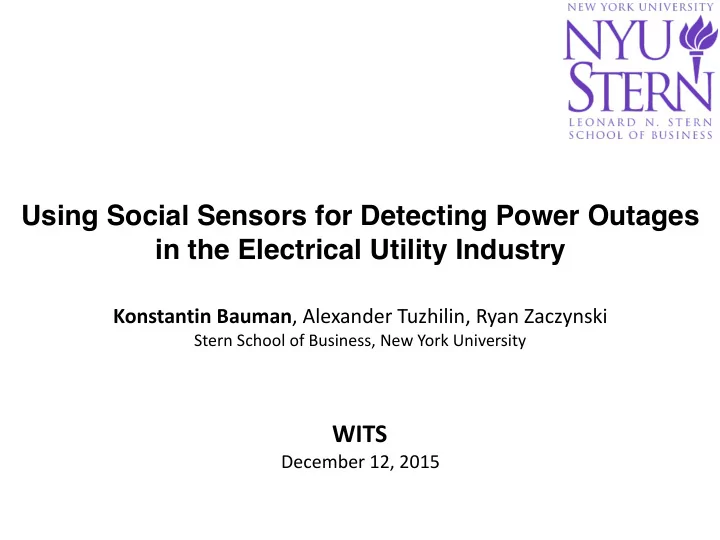

Using Social Sensors for Detecting Power Outages in the Electrical Utility Industry Konstantin Bauman , Alexander Tuzhilin, Ryan Zaczynski Stern School of Business, New York University WITS December 12, 2015
Power outages is a big problem • 3,634 power outages in 2014, affecting 14.2 million people • 2008-2013 the US has 2,987 outages on average affecting 21.6 million people annually • estimated losses in excess of $150 billion annually Solution : Detect PO as fast as possible! Question : HOW? Konstantin Bauman, Stern School of Business NYU Konstantin Bauman, Stern School of Business NYU
How to detect Power Failure Solution 1: Call center • increasing cost per call • take a lot of time • difficult to reach utilities during extensive power outages Solution 2: “Smart” Grid • total cost being estimated at $338 to $476 billion • fully implemented by only 2030 Solution 3: Social media We focus on Social Media approach Konstantin Bauman, Stern School of Business NYU Konstantin Bauman, Stern School of Business NYU
The power of tweets @ outages • People do tweet in case of power outages ICE STORM TORONTO 2013 2,641 TWEETS IN 24 HOURS Konstantin Bauman, Stern School of Business NYU
RESEARCH QUESTION How can we use social media (e.g. Twitter) for real-time power outage event detection? Konstantin Bauman, Stern School of Business NYU
OUR APPROACH Use automated data mining algorithms and burst detection methods for real-time power outage detection based on Twitter. Konstantin Bauman, Stern School of Business NYU
OUR SOLUTION Konstantin Bauman, Stern School of Business NYU
MANY WAYS TO SAY THAT YOUR POWER IS OUT Step 1: Building a set of Key Concepts • Identify the set of core concepts K • Compute closure C of set K by finding all “similar” concepts based on synonyms, variations, slang terms, misspellings, etc. Konstantin Bauman, Stern School of Business NYU
MANY WAYS TO SAY THAT YOUR POWER IS OUT Core concepts: “power outage,” “no power,” “electric failure” The Closure of core concepts: • 110 key concepts: Konstantin Bauman, Stern School of Business NYU
Step 2: Collecting Tweets containing key concepts • Use Twitter API to collect tweets having at least one key concept in real time • Outage detection within regions served by different power utility companies - 281 region in US Konstantin Bauman, Stern School of Business NYU
NOT ALL TWEETS WITH KEY CONCEPTS REPORT POWER OUTAGE Relevant • “Wow #%! we have a power outage rn?” • “#ferguson power outages due to .lightning” • “8/16 8:38PM - Power outage.” Irrelevant • “can there be an earthquake or power outage so that i can go home?” • “#KONE Widespread power outage hits Barstow - Victorville Daily Press http://t.co/4pmcVqJoRb #inlandempire” • “Flashlight cap. Perfect for power outage http://t.co/gAaXTI ” Konstantin Bauman, Stern School of Business NYU
NOT ALL TWEETS WITH KEY CONCEPTS REPORT POWER OUTAGE Step 3: Predictive Model Class 1 : Tweets posted by individuals witnessing power outages and immediately tweeting about them. Class 0 : all other tweets. Features for learning - length of the tweet in symbols/words/sentences, - presence of a URL link (True/False), - if the tweet is a re-tweet (True/False), - if the user name contains certain special words, such as ``news", ``police", ``power", etc., - sentiment, single words, and others. Konstantin Bauman, Stern School of Business NYU
Performance of the Predictive Models We use Logistic Regression because: •it shows good classification performance •the model is simple and fast in predicting new labels Konstantin Bauman, Stern School of Business NYU
Step 4: Identification of Power Outages • We cannot rely on a single tweet TWO PEOPLE , SAME BUILDING, THE UTILITY NEVER SAW IT Konstantin Bauman, Stern School of Business NYU
Step 4: Identification of Power Outages We use burst detection algorithm introduced in (Kleinberg 2002) • efficient, dealing with underlying noises • does not require human intervention Konstantin Bauman, Stern School of Business NYU
Step 5: Aspect Extraction of Power Outages Can we extract any additional information from tweets? We try to identify two aspects of power outages: • its reason, such as equipment failure or public accident • the weather condition at the time of the outage. This is accomplished using a set of predefined keywords. Example: for Vegetation category we use keywords: “tree,” “limb,” “branch,” “vines,” and “trunk.” Konstantin Bauman, Stern School of Business NYU
RESULTS Utility Power Outage Data • Utility company in a large municipal region in US • Power Outages for the period 10/25/2014 - 1/25/2015 Konstantin Bauman, Stern School of Business NYU
RESULTS (cont.) Outage Data Based on Reliable Twitter Accounts Reliable sources : news organizations, police departments and other “official” Twitter accounts. Power Outages for the period 8/25/2014 - 1/25/2015 We identify reliable Twitter user names based on a set of key words, such as: “news”, “police”, “power”, “electricity”, “weather”, “alert,” etc. Konstantin Bauman, Stern School of Business NYU
RESULTS (cont.) Outage Data Based on Reliable Twitter Accounts Konstantin Bauman, Stern School of Business NYU
CONCLUSION We presented a novel power outage detection method that • filters the tweets containing key concepts • identifies the tweets referring to real power outages • detects bursts among these identified tweets • identifies possible reasons of the outage and the weather conditions in the region at that time. We validated our method on two datasets and showed that it has • high precision measure - 93.7% and 97.6% • good recall measure - 36.5% and 56.3% The system identified • possible reason of power outage in 5.36% of the outages • weather conditions in the region in 10.32% of the outages Konstantin Bauman, Stern School of Business NYU
Thank you! Konstantin Bauman Stern School of Business NYU kbauman@stern.nyu.edu
Recommend
More recommend